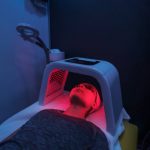Laser therapy can be a viable treatment option for certain types of pain, including those often related to knee pain. Laser therapy research is still beginning, and many insurance companies still believe it is an experiment. Some studies have shown it can relieve pain, such as knee pain.
Laser therapy is also called cold laser therapy or the class III form of laser therapy and low-level therapy (LLLT). A few early research studies have found that lasers can help heal wounds. This suggests they could help the body to repair tissue damage caused by injuries and arthritis or other illnesses. But the initial studies on cold therapy lasers weren’t controlled clinical trials.
Laser therapy is still relatively new, and scientists aren’t sure if there are any long-term dangers. Most studies have focused on immediate effects. Still, laser therapy can trigger long-term adverse effects that haven’t yet been discovered.
The latest information on laser treatment for knee pain:
- Laser therapy advocates say it can provide short-term pain relief and long-term healing.
- The advocates of laser therapy believe it is a treatment for ailments that range from arthritis to joint pain, chronic pain, as well as addictions like smoking cigarettes.
- Studies on pain in other parts of the body suggest that laser therapy may, at a minimum, provide temporary relief from pain.
- In contrast to surgical lasers, lasers don’t cause heat to tissues in the body.
What is laser therapy?
Laser therapy is regarded as more non-invasive than traditional surgery and carries a lower risk.
Lasers for surgical procedures are becoming more common in medicine. They can be cut more precisely than traditional surgical tools, reducing the danger of injury and speeding up surgery.
However, this is because these “hot” lasers can be hazardous if they are misused. On the other hand, lasers are “cold” lasers used in LLT to alleviate pain, are weaker than surgical lasers, and cannot penetrate or burn skin.
The proponents of laser therapy claim that the skin absorbs small amounts of light, allowing the laser to penetrate deep into the tissues. This helps repair damaged tissue without negative side consequences. Since the power is low, there isn’t any danger of a burn.
Can laser therapy ease knee discomfort?
Experts are still determining the correct answer to this issue.
The majority of research has been concentrated on osteoarthritis and chronic pain. If the laser therapy works, it needs to be clarified the mechanism behind it or how. Lasers can increase circulation, aid in the health of cells, release endorphins that fight pain, decrease inflammation, or stimulate the development of healthy and new tissue.
The preliminary research is promising. However, there isn’t any conclusive evidence that shows that cold therapy lasers can treat discomfort or treat any medical issue. Many insurance companies, as well as Medicare and Medicaid, cannot offer coverage for laser therapy.
What do the clinical research studies suggest?
A 2005 Cochrane Review trusted Source assessed the ability of LLT to reduce the pain of rheumatoid arthritis, a typical reason for knee pain. The study found evidence of moderate pain relief in the short term with a few adverse side negative effects.
A study conducted in 2009 by Trusted Source A 2009 survey by Trusted Source compared knee pain who had received LLT to those that believed they received LLT. Compared to the placebo group, laser therapy patients reported less discomfort.
Since it is not clear the mechanism of laser therapy, It isn’t known what the findings of these studies apply to the knee.
A 2008 study by Trusted Source reviewed prior studies that were placebo-controlled and randomized LLT to treat tennis elbow. The studies in the review did not explore the ways or reasons laser therapy eased pain or did not evaluate the effects of long-term pain relief.
The 2009 study looked at prior studies on laser therapy for neck pain. The study revealed significant relief from pain lasting between 22 and 23 weeks. Although adverse side effects afflicted some patients, these effects were not different from the ones experienced by the placebo.
Why is it so difficult to tell if it’s working?
One of the challenges of laser treatment is that various studies examine various wavelengths. This means it is hard to assess the effectiveness of one treatment to one. In addition, different laser manufacturers offer additional suggestions regarding treatment duration and frequency.
Laser therapy is expected to become an established procedure for treating knee pain doctors must know the most effective wavelength and the correct dosage.




